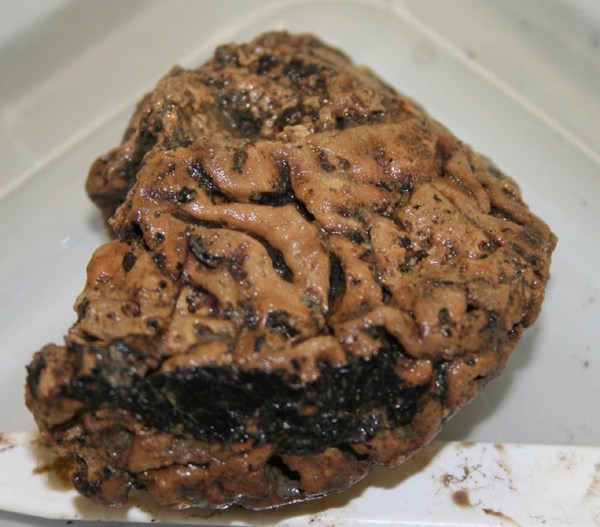 Weird Stuff
Weird Stuff  Weird Stuff
Weird Stuff  Health
Health Ten Confounding New Inventions from the World of Biomedicine
 Creepy
Creepy 10 Death Superstitions That Will Give You the Creeps
 Movies and TV
Movies and TV 10 Movies That Get Elite Jobs Right, According to Experts
 Weird Stuff
Weird Stuff 10 Times Real Laws Were Based on Bizarre Hypotheticals
 Animals
Animals 10 Inspiring Tales of Horses Being Human
 Mysteries
Mysteries Top 10 Haunting Facts About the Ghost Ship MV Alta
 History
History 10 Surprising Stories About the Texas Rangers
 Humans
Humans 10 Philosophers Who Were Driven Mad by Their Own Theories
 Miscellaneous
Miscellaneous 10 Video-Game-Worthy Weapons and Armors from History
 Weird Stuff
Weird Stuff 10 Warning Labels That Exist Because Someone Actually Tried It
 Health
Health Ten Confounding New Inventions from the World of Biomedicine
 Creepy
Creepy 10 Death Superstitions That Will Give You the Creeps
Who's Behind Listverse?

Jamie Frater
Head Editor
Jamie founded Listverse due to an insatiable desire to share fascinating, obscure, and bizarre facts. He has been a guest speaker on numerous national radio and television stations and is a five time published author.
More About Us Movies and TV
Movies and TV 10 Movies That Get Elite Jobs Right, According to Experts
 Weird Stuff
Weird Stuff 10 Times Real Laws Were Based on Bizarre Hypotheticals
 Animals
Animals 10 Inspiring Tales of Horses Being Human
 Mysteries
Mysteries Top 10 Haunting Facts About the Ghost Ship MV Alta
 History
History 10 Surprising Stories About the Texas Rangers
 Humans
Humans 10 Philosophers Who Were Driven Mad by Their Own Theories
 Miscellaneous
Miscellaneous 10 Video-Game-Worthy Weapons and Armors from History
10 Weird and Grotesque Archaeological Finds
History is full of surprises, and archaeology allows us a rare glimpse into the past that often reveals more than any textbook ever could. Every discovery helps to dig up new information about the way the world was in the time of our ancestors. From vampires to giant man-crushing wombats, here are ten of the strangest archaeological finds.

Twenty-five human skulls were found in a mass grave in Mexico with long skulls making them look like aliens.
Mexican villagers were digging into the ground when they found a mass grave, filled with 25 ancient corpses. Around half of the bodies had freakishly long skulls. Although some people were quick to suggest that the bodies were those of aliens, researchers believe that the skulls were reshaped on purpose – while their owners were still alive.
Children in the Central American cultures of 1,000 years ago had their skulls forced into odd shapes from a young age. Their heads were bound with flat boards, which put enormous pressure on their skulls. The pressure forced the bone tissue to grow upwards rather than outwards – resulting in something that looks a lot like an alien.

The blood of this murdered French king was found on a handkerchief proving that people took mementos from his execution place.
The remains of a handkerchief from the French Revolution is soaked with the blood of King Louis XVI, scientists have found. Legend has it that when the king was killed in 1792, people rushed forward and dipped their handkerchiefs in his blood – a story which seems to be true, now that the blood stains have been shown to be his.
DNA testing didn’t prove anything until the handkerchief was compared to a mummified head that probably belonged to King Henry IV, a direct ancestor of King Louis. Both of the finds – the head and the blood – were verified at exactly the same time.

This ancient ice-corpse was discovered with perfectly preserved blood – the oldest in the world.
In 1991, a group of hikers were trekking in the mountains of Austria when they came across an awful sight: a frozen body was buried in the ice at their feet. That body belonged to a 5,300 year old man, later dubbed “Otzi the Iceman”. By studying the body, scientists have been able to discover some surprisingly specific facts. When he was alive, he had parasites in his intestines, was lactose intolerant, and had been sick three times in the past six months. But his death seems to have been caused by an arrow wound to his back – leading some scientists to believe that he was chased across the mountains.
The most important find was not the body itself, but what was still inside it: Otzi’s blood cells were so well preserved that they look almost exactly like modern day blood samples. This makes it the world’s oldest blood – which teaches us a lot about the lifestyle of ancient man.

Giant wombats were found in an Australian mass grave with 20-foot long poisonous lizards and mega-kangaroos.
Wombats may well be some of the cutest animals on earth – but their ancestors were the stuff nightmares are made of. These ancient wombats were something like a cross between a rhinoceros and a grizzly bear. In 2012, Australian scientists found a mass grave filled with about 50 “mega-wombat” skeletons. They were about the size of a Volvo, could weigh as much as 3.1 tons (2.8 metric tons), and had a pouch large enough to hold “a small human.”
The mega-wombat graveyard also held bones from 20-foot-long poisonous lizards and 14-foot-tall “super kangaroos” – proving that Australia could kill you even in ancient times.

A perfectly preserved Iron Age brain was found pickled inside its skull.
An amazingly intact human brain was found inside a skull in Northern England. By sheer accident, the brain was naturally preserved – like pickled onions – in a way that stopped bacteria from breaking down the soft tissue.
The brain is thought to date from the Iron Age. The head was found without its body – leading some to believe that the head was removed during a ritual ceremony and buried apart from the body.

49,000 year old human bones with human gnaw marks on them were uncovered in Spain.
A small group of Neanderthal skeletons have been found at a dig site in Spain. The bones, which are about 49,000 years old, all have human teeth marks on them – which points pretty conclusively to cannibalism. It seems from the evidence that the group of twelve – six adults, three teenagers, two children, and an infant – were a family that was attacked and eaten by another party of Neanderthals, after taking shelter in a cave.

Bodies laid out in patterns give proof for mass human sacrifices in Peru.
In 2012, a tomb was found in Peru that held dozens of human skeletons. The adult skeletons were arranged inside a circle of baby skeletons. The tomb was found at the temple of Pachacamac, a major dig site which can claim nearly twenty pyramids and another cemetery to its name.
The temple is thought to be the place where sacrifices were carried out by the Ychsma, an ancient people who pre-dated the Incas. It seems that the bodies found inside the ring of babies belonged to pilgrims, who traveled to this tribe in search of some sort of cure – but a cure for what, nobody knows.

Bodies of the undead are regularly found in Bulgaria with iron stakes still embedded in their hearts.
Bulgarians in the 14th century would stab the hearts of anybody who was thought to be a vampire. It seems that the Middle Ages were even more crazy about vampires than we are today. Over 100 vampire graves have been found scattered across the country – all of them with an iron stake driven through the chest of the body.
A vampire corpse, recently found near the coast of the Black Sea, appears to have been stabbed many times and then buried with the stake still protruding from its chest. Grave sites like this are found every few years, and nobody knows just how many people in the region were put to death as vampires.
Missing pages of this famous book are still showing up in unexpected places.
The Egyptian Book of the Dead is one of the most famous books containing spells to be used in the afterlife. Rather than being a single book, it is more of a concept. The spells were usually written on the walls and on the bodies of the deceased. Upper class Egyptians were also given a papyrus scroll with the spells written on it, which would allow them to journey through the afterlife.
Researchers have spent years trying to track down all the pieces of the Book of the Dead given to Amenhotep, a powerful Egyptian official from around 1400 BC. Nearly 100 fragments of this scroll were recently found – not in a sandy tomb, but in the basement of the Queensland Museum, where they were donated almost 100 years ago.

Vikings corpses prove that they were so tough they refused to be killed from behind and preferred to face their executioner.
In 2009, a Viking mass grave was found by a road crew in Dorset, UK. The bodies – 51 in total – had been brutally executed and then left with their heads in one pile and the rest of their bones in another pile. Researchers think that this might be the grave of the feared Jomsvikings, a mercenary group that carried out a series of violent raids along the coast of England around 1000 AD.
From looking at the bones, it seems that the victims’ heads were cut off from the front. As proud Vikings, the captives refused to turn their backs to their killers.









